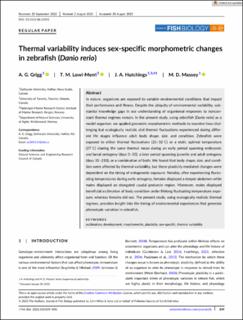| dc.description.abstract | In nature, organisms are exposed to variable environmental conditions that impact their performance and fitness. Despite the ubiquity of environmental variability, substantial knowledge gaps in our understanding of organismal responses to nonconstant thermal regimes remain. In the present study, using zebrafish (Danio rerio) as a model organism, we applied geometric morphometric methods to examine how challenging but ecologically realistic diel thermal fluctuations experienced during different life stages influence adult body shape, size, and condition. Zebrafish were exposed to either thermal fluctuations (22–32°C) or a static optimal temperature (27°C) sharing the same thermal mean during an early period spanning embryonic and larval ontogeny (days 0–30), a later period spanning juvenile and adult ontogeny (days 31–210), or a combination of both. We found that body shape, size, and condition were affected by thermal variability, but these plasticity-mediated changes were dependent on the timing of ontogenetic exposure. Notably, after experiencing fluctuating temperatures during early ontogeny, females displayed a deeper abdomen while males displayed an elongated caudal peduncle region. Moreover, males displayed beneficial acclimation of body condition under lifelong fluctuating temperature exposure, whereas females did not. The present study, using ecologically realistic thermal regimes, provides insight into the timing of environmental experiences that generate phenotypic variation in zebrafish. | |
